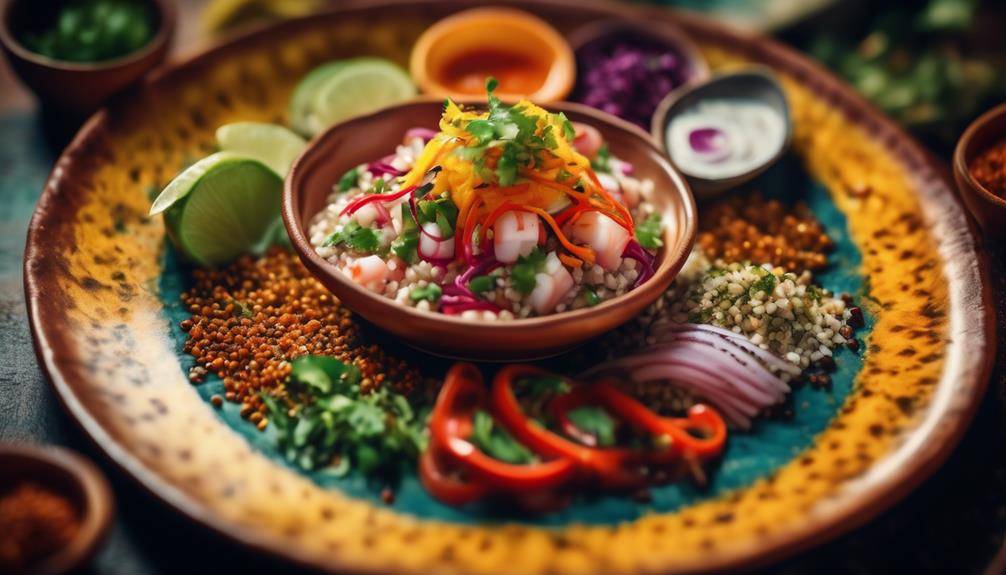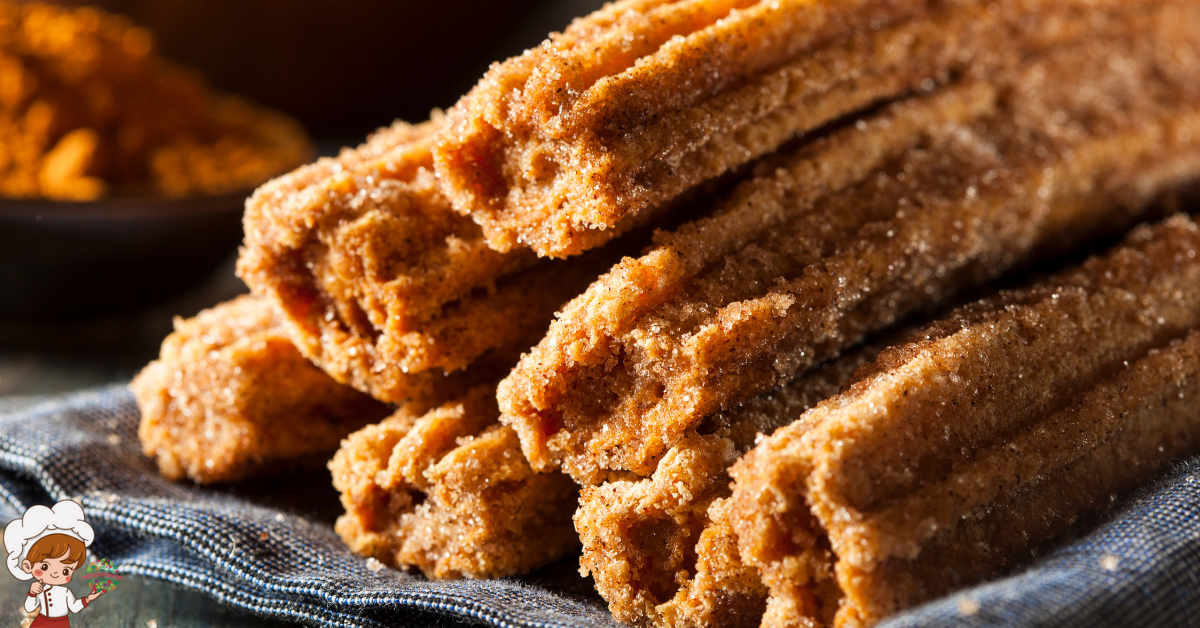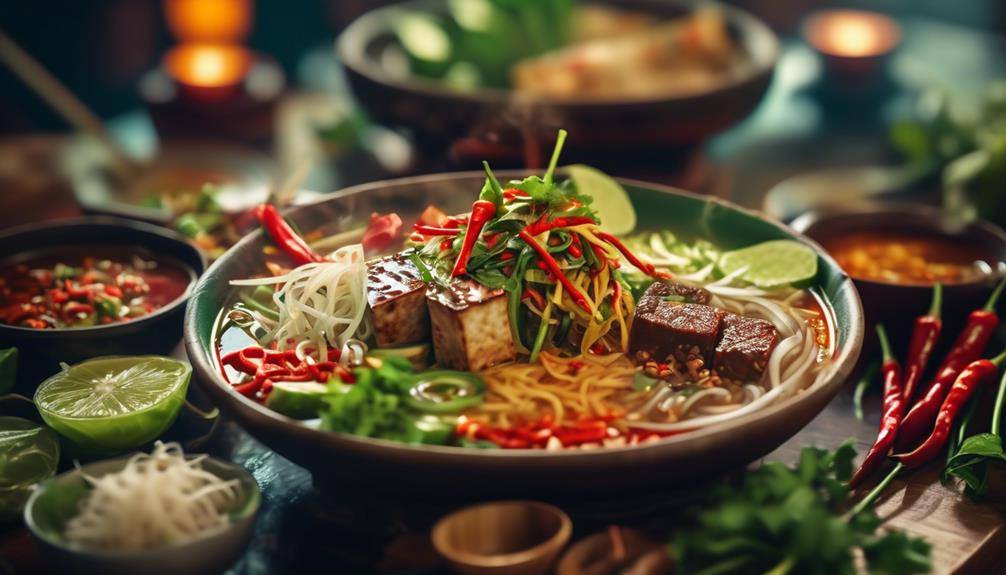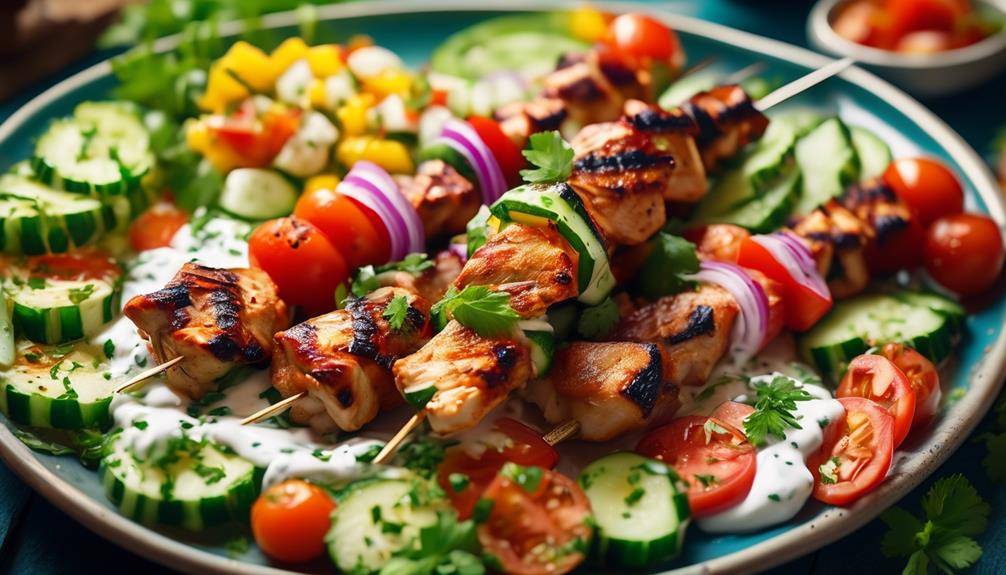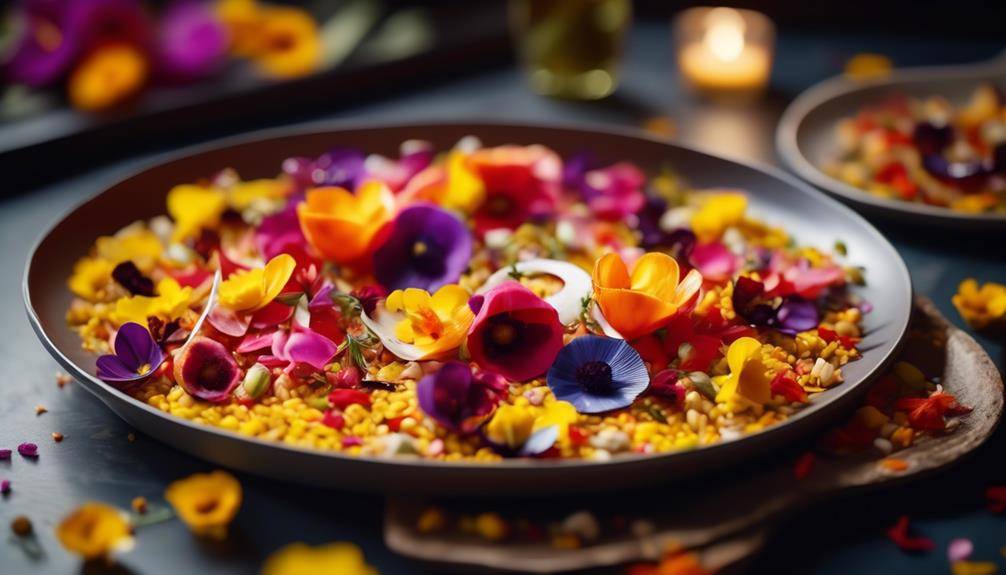The Best Peruvian Cuisine And Its Coastal Specialties
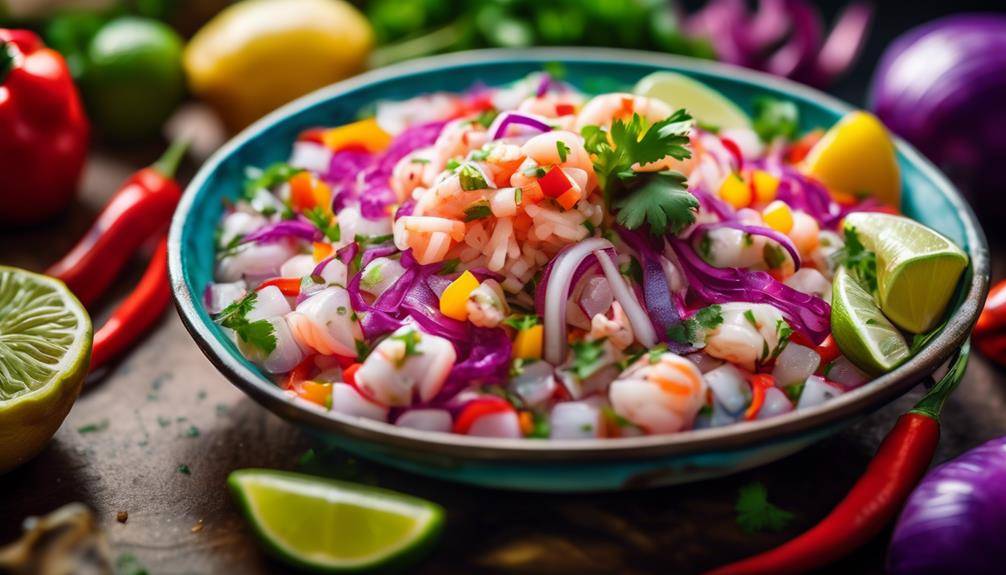
Peruvian Cuisine And Its Coastal Specialties; Step into the vibrant world of Peruvian cuisine, where the flavors dance like waves along the coastal shores. From the fusion of indigenous and Spanish influences to the exquisite delicacies made with fresh seafood, Peruvian coastal specialties are a true treat for the senses. But what makes these dishes so unique? How do they capture the essence of Peru’s coastal regions? Join us as we embark on a culinary journey, unraveling the secrets behind the art of ceviche, the raw seafood delight of tiradito, and the potato-based delicacy known as causa. Get ready to savor the flavors of Peru’s coastal treasures and discover the regional specialties that make this cuisine truly unforgettable.
Traditional Peruvian Coastal Dishes
When it comes to the culinary delights of Peru’s coastal region, you will find a diverse array of traditional dishes that showcase the rich flavors and ingredients unique to this vibrant coastal culture. Traditional Peruvian coastal dishes are deeply rooted in the region’s history and reflect the cultural significance of the coastal communities.
One of the most iconic dishes is ceviche, a refreshing and tangy seafood dish. It is made by marinating fresh fish or seafood in lime juice, which effectively “cooks” the raw seafood. This traditional cooking technique, known as “cooking with acid,” has been used for centuries by the coastal communities to preserve and enhance the flavors of the seafood. The acidity of the lime juice not only adds a burst of freshness but also acts as a natural tenderizer, resulting in a delicate texture.
Another popular dish is causa, a layered potato dish that showcases the versatility of potatoes, a staple ingredient in Peruvian cuisine. The dish is made by combining mashed potatoes with lime juice, ají amarillo (a yellow chili pepper), and oil. The mixture is then layered with various fillings such as chicken, tuna, or avocado. The dish is often garnished with hard-boiled eggs, olives, and aji sauce. The traditional cooking technique of boiling and mashing the potatoes, combined with the unique flavors of the ají amarillo, creates a dish that is both hearty and satisfying.
These traditional Peruvian coastal dishes not only delight the taste buds but also tell a story of the coastal communities and their deep connection to the sea. The traditional cooking techniques and the cultural significance of these dishes have been passed down through generations, preserving the rich culinary heritage of Peru’s coastal region.
Fusion of Flavors: Indigenous and Spanish Influences
As we explore the fusion of flavors in Peruvian cuisine, we dive into the fascinating blend of indigenous and Spanish influences that have shaped the culinary landscape of Peru’s coastal region. The indigenous culinary traditions of Peru have a rich history that dates back thousands of years. The Inca civilization, with its advanced agricultural techniques, cultivated a wide range of crops including potatoes, corn, quinoa, and various fruits. These ingredients formed the foundation of their cuisine and continue to be prominent in Peruvian dishes today.
When the Spanish arrived in Peru in the 16th century, they brought with them a new set of ingredients and cooking techniques. The Spanish influence on Peruvian cuisine can be seen in the introduction of ingredients like wheat, rice, and various meats such as beef, pork, and chicken. The Spanish also brought with them their culinary techniques, such as frying, baking, and braising, which were incorporated into the indigenous cooking methods.
The fusion of indigenous and Spanish flavors resulted in a diverse and vibrant culinary tradition. One notable example is ceviche, a dish that showcases the fusion of indigenous and Spanish influences. Ceviche is made by marinating fresh fish or seafood in citrus juices, usually lime or lemon, which is a technique borrowed from the Spanish. However, the addition of indigenous ingredients such as corn, sweet potatoes, and ají peppers adds a unique Peruvian twist to the dish.
The cultural influences on Peruvian cuisine extend beyond the ingredients and cooking techniques. The blending of indigenous and Spanish cultures has also shaped the way food is enjoyed and celebrated in Peru. Traditional Peruvian meals are often communal, with family and friends gathering around a table to share a variety of dishes. This sense of togetherness and celebration is a reflection of the cultural values that have been passed down through generations.
Fresh Seafood Delicacies
Get ready to tantalize your taste buds with the freshest catch of the day in Peruvian coastal cuisine. From succulent ceviche variations bursting with zesty flavors to perfectly grilled octopus that melts in your mouth, the seafood delicacies in Peru are a true culinary masterpiece. Experience the rich flavors and textures of Peru’s abundant coastal waters as you savor these exquisite dishes that showcase the country’s passion for fresh seafood.
Catch of the Day
Peruvian coastal cuisine boasts an array of fresh seafood delicacies, showcasing the vibrant flavors of the ocean. The catch of the day in Peru is truly a culinary delight. The coastal fishing techniques employed by Peruvian fishermen ensure the availability of the freshest and highest quality seafood. These techniques, passed down through generations, include net fishing, line fishing, and even the use of traditional reed boats called “caballitos de totora.”
Peruvian fishermen are also committed to sustainable seafood sourcing, protecting the delicate marine ecosystems. They follow strict regulations and prioritize responsible fishing practices to preserve the abundance of the ocean’s offerings for future generations. This dedication to sustainability not only ensures the freshness of the catch of the day but also promotes the preservation of Peru’s rich coastal biodiversity.
Ceviche Variations
With its rich coastal bounty, Peruvian cuisine offers a tantalizing array of ceviche variations, showcasing the freshness and delicate flavors of the finest seafood delicacies. Ceviche is a popular dish in Peru, known for its simple yet flavorful preparation. The key to a good ceviche lies in the quality and freshness of the seafood used. Typically, raw fish or shellfish is marinated in a mixture of lime juice, onions, and chili peppers. The acid from the lime juice “cooks” the seafood, resulting in a firm yet tender texture.
The ceviche marinade not only enhances the natural flavors of the seafood but also adds a refreshing tanginess to the dish. Some variations incorporate additional ingredients like cilantro, garlic, or even fruit, providing a unique twist to the traditional recipe. Whether you prefer a classic ceviche or one with a modern twist, Peruvian cuisine has something to offer for every seafood lover.
Grilled Octopus Perfection
Grilled to perfection, the tender and succulent octopus of Peruvian cuisine is a true delight for seafood enthusiasts. The grilled octopus recipe is a testament to the culinary mastery of Peruvian chefs, who skillfully combine traditional techniques with innovative flavors. Here are three grilling techniques for seafood that elevate the octopus dish to new heights:
- Charcoal Grilling: The smoky aroma and charred flavors imparted by grilling the octopus over hot charcoal create a unique and irresistible taste.
- Marination: Before grilling, the octopus is marinated in a blend of olive oil, garlic, lemon juice, and spices. This step enhances the tenderness and infuses the meat with a burst of tangy and savory flavors.
- Proper Timing: Grilling octopus requires precise timing to achieve the perfect balance of tender and slightly crispy texture. The octopus is grilled for just the right amount of time to ensure it remains tender and juicy.
Indulge in the grilled octopus perfection of Peruvian cuisine and experience the tantalizing flavors that await you.
The Art of Ceviche: A Peruvian Culinary Icon
Get ready to embark on a culinary journey as you explore the art of ceviche, a beloved icon of Peruvian cuisine. Discover the origins and rich history of this dish, which dates back centuries and reflects the cultural fusion that defines Peru. Learn about the traditional ingredients that make ceviche so unique, from the freshest seafood to the vibrant flavors of lime, chili peppers, and cilantro. Get ready to tantalize your taste buds and appreciate the craftsmanship behind this culinary masterpiece.
Origins and History
Ceviche, a beloved dish in Peruvian cuisine, holds a rich history and cultural significance that has made it an iconic culinary masterpiece. Its origins and history can be traced back to pre-Columbian times, where it was believed to have been consumed by the Moche civilization along the coast of Peru. Over the centuries, ceviche underwent a culinary evolution, influenced by various cultures and traditions.
- Spanish Influence: During the Spanish colonization of Peru, the introduction of citrus fruits like lime and oranges transformed ceviche into the tangy and refreshing dish we know today.
- Japanese Influence: In the late 19th century, Japanese immigrants brought their own culinary techniques to Peru, including the use of raw fish in dishes. This fusion of flavors resulted in the popularization of sushi-grade fish in ceviche.
- Modern Innovations: In recent years, chefs have experimented with different ingredients and flavors, expanding the traditional ceviche recipe to include variations with seafood, fruits, and even vegetarian options.
The culinary evolution of ceviche reflects the vibrant and diverse history of Peru, making it a true emblem of the country’s gastronomy.
Traditional Ingredients
The evolution of ceviche throughout history has led to the creation of a dish that showcases the traditional ingredients that make it a true culinary icon in Peru. Traditional cooking techniques and cultural significance play a significant role in the preparation of this beloved dish. The key ingredient in ceviche is fresh fish, typically white fish such as sea bass or flounder. The fish is then marinated in a mixture of lime juice, onions, chili peppers, and cilantro.
The acidity of the lime juice “cooks” the fish, giving it a unique texture and flavor. Other traditional ingredients include sweet potatoes, corn, and cancha, a type of toasted corn. These ingredients not only add depth to the dish but also reflect the diverse agricultural heritage of Peru. The combination of these traditional ingredients, along with the skillful use of traditional cooking techniques, creates a ceviche that is both delicious and culturally significant.
Tiradito: A Raw Seafood Delight
With its vibrant colors and delicate flavors, Tiradito is a tantalizing dish that showcases the freshness and exquisite taste of raw seafood in Peruvian cuisine. This culinary delight is a popular coastal specialty that combines the best of Japanese and Peruvian flavors, creating a truly unique and mouthwatering experience.
- Freshness: One of the key elements of Tiradito is the use of incredibly fresh raw seafood. Whether it’s tender slices of fish, such as sea bass or tuna, or succulent shrimp and octopus, the quality of the seafood is paramount. The raw seafood is the star of the dish, and its freshness enhances the overall taste and texture.
- Citrus marinade: Another distinctive feature of Tiradito is the citrus-based marinade that is used to “cook” the raw seafood. Lime juice is typically the main component, but other citrus fruits like lemon or orange might also be used. The acidic marinade not only adds a zesty and refreshing flavor but also helps to tenderize the seafood, enhancing its delicate texture.
- Chili kick: Peruvian cuisine is known for its love of spicy flavors, and Tiradito is no exception. The dish is often garnished with a drizzle of spicy chili sauce, such as ají amarillo or rocoto, which adds a delightful kick to the dish. The combination of the tangy citrus, fresh seafood, and fiery chili creates a perfect balance of flavors.
Tiradito is a dish that not only highlights the raw seafood but also celebrates the artistry and precision of Peruvian cooking. The careful slicing of the seafood, the delicate balance of marinade ingredients, and the artful presentation all contribute to making Tiradito a culinary masterpiece. So next time you crave a raw seafood delight, indulge in the vibrant and tantalizing flavors of Tiradito, a true gem of Peruvian cuisine.
Causa: A Potato-Based Delicacy
As we continue our exploration of Peruvian coastal specialties, we now turn our attention to the delectable potato-based delicacy known as Causa. Causa is one of the most beloved potato-based appetizers in traditional Peruvian cuisine. With its vibrant colors and rich flavors, it is a true reflection of the diverse culinary heritage of Peru.
Causa is made by layering mashed potatoes seasoned with a touch of lime juice and yellow chili pepper. The potatoes are then filled with various mouthwatering ingredients such as avocado, chicken, tuna, or shrimp. The layers are carefully stacked to create a visually appealing dish that is as beautiful as it is delicious.
What sets Causa apart from other potato-based dishes is its versatility. It can be served as an appetizer or a main course, depending on the filling and portion size. The combination of flavors and textures in each bite is a true delight for the taste buds.
The origins of Causa can be traced back to the Inca Empire, where potatoes were a staple crop. The dish has evolved over time, incorporating influences from Spanish and Japanese cuisines, resulting in a unique fusion of flavors.
Causa is not only a culinary masterpiece but also a symbol of Peruvian pride. Its vibrant colors represent the diversity and abundance of ingredients found in the region. Whether enjoyed by locals or visitors, Causa is sure to leave a lasting impression and a desire for more of Peru’s tantalizing potato-based delicacies.
Coastal Regional Specialties
Coastal Peru boasts a plethora of unique and enticing regional specialties that showcase the bountiful ingredients and culinary creativity found in this vibrant region. From the fresh seafood caught in the Pacific Ocean to the abundance of fruits and vegetables grown in the fertile coastal valleys, the regional culinary highlights of Coastal Peru are a true testament to the richness of its land and waters.
- Ceviche: A quintessential coastal dish, ceviche is a refreshing and tangy seafood dish that is made by marinating raw fish or shellfish in citrus juices, typically lime or lemon. The acid from the citrus juices denatures the proteins in the seafood, effectively “cooking” it without heat. This technique results in a dish that is bursting with vibrant flavors and a unique texture.
- Tiradito: Another popular seafood dish in Coastal Peru, tiradito is similar to ceviche but with a twist. It is made by thinly slicing raw fish and dressing it with a spicy and tangy sauce made from aji amarillo, lime juice, and other seasonings. The dish is often garnished with slices of avocado or sweet potato and is a true testament to the coastal cooking techniques of Peru.
- Arroz con Mariscos: A delightful rice dish that showcases the abundance of seafood in Coastal Peru. It is made by sautéing a mixture of seafood, such as shrimp, squid, and mussels, with onions, garlic, and aji amarillo. The seafood is then cooked with rice and flavored with a combination of fish stock, beer, and spices. The result is a flavorful and aromatic dish that perfectly captures the essence of coastal cuisine.
Coastal Peru’s regional specialties are a true testament to the culinary creativity and the richness of the land and waters. From the tangy ceviche to the flavorful tiradito and the aromatic arroz con mariscos, these dishes highlight the coastal cooking techniques and the diverse flavors that make Peruvian cuisine so unique.
Peruvian Cuisine And Its Coastal Specialties; Frequently Asked Questions
What Are Some Traditional Peruvian Coastal Dishes That Are Not Commonly Known?
You might not be aware of the lesser known seafood delicacies from the Peruvian coast. Peruvian coastal dishes offer a wide array of unique flavors and ingredients that will surely tantalize your taste buds.
How Did the Fusion of Indigenous and Spanish Flavors Contribute to the Development of Peruvian Coastal Cuisine?
The fusion of indigenous and Spanish flavors in Peruvian coastal cuisine contributed to its development. Cultural influences shaped the unique blend of ingredients and cooking techniques, resulting in a rich and diverse culinary tradition.
Are There Any Unique Seafood Delicacies From the Peruvian Coast That Are Not Commonly Found in Other Parts of the World?
There are indeed unique seafood delicacies from the Peruvian coast that are not commonly found in other parts of the world. These Peruvian seafood specialties are known for their distinct flavors and are a must-try for any seafood lover.
What Makes Ceviche Such an Iconic Dish in Peruvian Cuisine?
Ceviche, an iconic Peruvian dish, holds cultural significance due to its vibrant flavors and unique preparation techniques. It showcases the influence of local ingredients and reflects the regional variations of Peruvian coastal cuisine.
Can You Explain the Difference Between Tiradito and Ceviche, and Why Tiradito Is Considered a Raw Seafood Delight?
Tiradito and ceviche are both Peruvian coastal dishes, but the difference lies in the preparation. While ceviche is marinated in citrus juice, tiradito is thinly sliced and served raw. Tiradito is considered a raw seafood delight due to its delicate flavors and fresh presentation.
Conclusion
In conclusion, Peruvian coastal cuisine offers a delightful fusion of flavors that showcases the rich culinary heritage of the region. From the iconic ceviche to the mouthwatering tiradito and potato-based causa, these traditional dishes highlight the indigenous and Spanish influences that have shaped Peruvian gastronomy. With its abundance of fresh seafood and unique ingredients, Peruvian coastal specialties are a true culinary delight for food enthusiasts seeking a taste of authentic and flavorsome cuisine.



